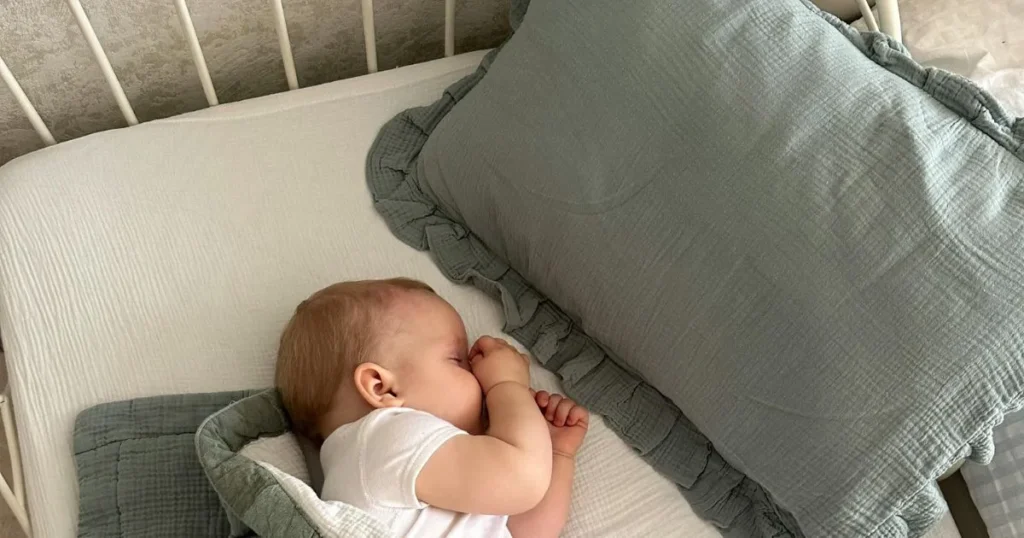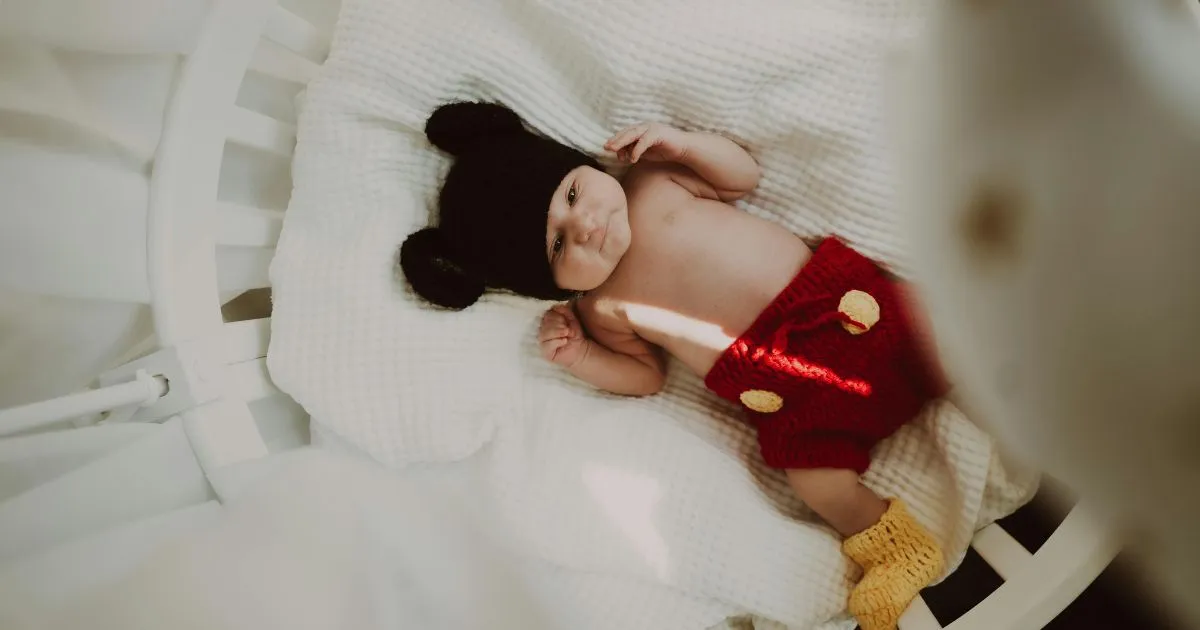One of the biggest challenges new parents face is learning how to get newborn to sleep in crib. After months of cuddling and constant closeness, the crib can feel like an unfamiliar, less comforting place. But with the right strategies, your baby can make a smooth transition to crib sleeping, and you can both enjoy a peaceful night’s rest.
In this article, we’ll explore the best methods to help your baby sleep soundly in their crib. Whether your newborn struggles with the crib or wakes up as soon as they’re placed down, these proven tips can make a significant difference.
Table of Contents
Why Does Your Newborn Resist the Crib?
Understanding why your newborn won’t sleep in the crib is the first step in solving the problem. Here are some common reasons your baby may resist sleeping in the crib:
- Comfort and Security: Your baby has been used to the warmth of your body and the safety of being close to you. The crib feels too distant or unfamiliar.
- Startle Reflex: The Moro reflex can cause your baby to feel as though they’re falling when laid down, causing them to wake up quickly.
- Hunger or Discomfort: Babies may wake up if they are hungry, need a diaper change, or simply don’t feel comfortable in their crib.
With patience and consistency, you can address these issues and begin to teach your baby how to get newborn to sleep in crib.
1. Establish a Consistent Bedtime Routine
A consistent bedtime routine helps your newborn feel secure and ready for sleep. Babies thrive on routine and find comfort in knowing what comes next. Here are steps you can follow to establish a successful bedtime routine:
- Bath Time: Start with a relaxing bath to calm your baby and signal that it’s time for bed.
- Feeding: After the bath, feed your baby so they’re content and ready to sleep.
- Rocking or Cuddling: Gently rock your baby or hold them close for a few minutes to help them feel comforted and relaxed before placing them in the crib.
By consistently following the same steps every night, your baby will begin associating these actions with sleep and may begin to feel more comfortable in the crib.
2. Gradually Transition to the Crib
If your baby is used to sleeping in your arms or a bassinet, moving to a crib may feel overwhelming. A gradual transition can help your newborn adjust with minimal stress. Here’s how you can do it:
- Start with Daytime Naps: Begin by placing your baby in the crib for naps during the day. This allows them to become familiar with the crib in a less stressful environment.
- Put Your Baby Down While Drowsy: Instead of waiting until your baby is fully asleep, try placing them in the crib when they’re drowsy but still awake. This helps them learn to self-soothe and fall asleep independently in the crib.
- Comforting Presence: In the early stages, stay in the room and offer reassurance by patting or speaking softly to your baby. Gradually, reduce your presence as they become more accustomed to sleeping in the crib.
A gradual transition allows your newborn to feel more secure, increasing the chances that they will stay asleep in the crib.
3. Swaddle for Security and Comfort
Swaddling can be a game-changer when it comes to how to get newborn to sleep in crib. It mimics the feeling of being in the womb, providing your baby with a sense of security. The swaddle also helps reduce the startle reflex, making it easier for your baby to stay asleep.
Follow these tips for safe swaddling:
- Use Soft, Breathable Fabrics: Always choose breathable fabrics like cotton to avoid overheating.
- Ensure a Snug Fit: The swaddle should be tight around the chest but loose enough around the hips to avoid restricting movement.
- Stop Swaddling When Baby Can Roll: Once your baby shows signs of being able to roll over, stop swaddling to reduce the risk of suffocation.
Swaddling can be a crucial step in helping your baby feel secure in the crib and sleep for longer stretches.
4. Make the Crib a Safe, Comfortable Space
A safe and comfortable crib is essential for encouraging your baby to sleep. Here’s how to optimize the crib environment:
- Firm Mattress: A firm mattress is crucial for safety and comfort. Soft mattresses can pose a suffocation risk.
- Keep Bedding Simple: Avoid using pillows, blankets, or stuffed animals in the crib. These can increase the risk of suffocation and make your baby uncomfortable.
- Appropriate Clothing: Dress your baby in light, breathable clothes that keep them comfortable without causing overheating.
The more comfortable and secure your baby feels in their crib, the more likely they are to sleep soundly.
5. Use White Noise to Help with Sleep
If you’ve been wondering how to get newborn to sleep in crib, white noise could be the answer. Babies are used to noise in the womb, and silence can make them feel startled or unsettled. A white noise machine can create a soothing environment that mimics the sound of the womb.
Here’s how to use white noise effectively:
- Choose a White Noise Machine: Invest in a good-quality machine that can play continuous, soothing sounds such as white noise or gentle lullabies.
- Set the Volume Appropriately: The noise should be loud enough to mask household sounds but not so loud that it disrupts sleep.
- Keep the Sound Consistent: Make sure the white noise continues throughout the night to help your baby sleep better in the crib.
White noise can make the crib feel more familiar and comforting to your baby, helping them stay asleep once placed down.
6. Use a Comforting Sleep Association

Sometimes, your baby may need an extra level of comfort to feel secure in the crib. Comfort items like a pacifier, a soft blanket, or a cloth that smells like you can offer that reassurance. These small items provide a sense of familiarity and can help your baby settle into the crib.
Here’s how to incorporate comfort items:
- Choose a Safe Comfort Object: Make sure any item you place in the crib is safe, particularly when your baby is under 6 months old.
- Introduce the Item Gradually: If you decide to use a pacifier or blanket, introduce it during your bedtime routine to create positive associations with sleep.
Comforting sleep associations help create a peaceful sleep environment that your baby can connect with over time.
FAQ: How to Get Newborn to Sleep in Crib
1. What are the best tips for getting my newborn to sleep in the crib?
Establishing a bedtime routine, gradually transitioning from your arms or bassinet, swaddling for comfort, and creating a safe, soothing environment with white noise are all excellent strategies for how to get newborn to sleep in crib.
2. Why does my newborn wake up when placed in the crib?
Newborns often wake up when placed in the crib because of the startle reflex, discomfort, hunger, or anxiety. Gradual transitions, swaddling, and creating a secure sleep environment can help reduce these issues.
3. Should I let my baby cry it out in the crib?
Choosing to use the “cry it out” method is a personal choice. If you choose this method, ensure that your baby is not hungry or in need of a diaper change. If you prefer a gentler approach, comfort your baby without picking them up and gradually reduce your presence.
4. How long will it take to get my newborn to sleep in the crib?
It may take anywhere from a few days to a few weeks for your baby to adjust to sleeping in the crib. Consistency, patience, and a soothing environment are key to making the transition as smooth as possible.
Now that you know how to get newborn to sleep in crib, you can take actionable steps to make the transition smoother for both you and your baby. Creating a consistent routine, swaddling, using white noise, and ensuring the crib is a safe and comfortable space are all key strategies for success. By following these expert tips, your newborn will soon be sleeping peacefully in their crib, allowing both of you to enjoy a restful night.
With time, patience, and a little bit of trial and error, you’ll master the art of crib sleeping, and your newborn will feel secure and comforted in their own space. So, don’t give up—your baby’s restful sleep is just around the corner.
